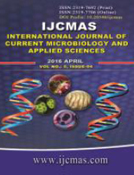


 National Academy of Agricultural Sciences (NAAS)
National Academy of Agricultural Sciences (NAAS)

|
PRINT ISSN : 2319-7692
Online ISSN : 2319-7706 Issues : 12 per year Publisher : Excellent Publishers Email : editorijcmas@gmail.com / submit@ijcmas.com Editor-in-chief: Dr.M.Prakash Index Copernicus ICV 2018: 95.39 NAAS RATING 2020: 5.38 |
This study aimed to synthesize silver nanoparticles using aqueous sidr leaves extract and to evaluate the antibacterial efficacy of sidr leaves extract, silver nitrate and silver nanoparticles against gram positive (Staphylococcus aureus and Streptococcus pyogenes) and gram-negative (Escherichia coli, Pseudomonas aeruginosa and Klebsiella pneumoniae) bacteria using agar well diffusion technique. The synthesis of silver nanoparticles using sidr leaves extract was successfully carried out. UV-Vis Spectrophotometer, Field Emission Scanning Electron Microscope (FE-SEM) and X-ray diffraction (XRD) analysis confirmed synthesis of silver nanoparticles. The UV–visible spectra showed that the absorption peak was existed at 442nm. FE-SEM analysis demonstrated that the synthesized AgNPs were ellipsoidal and spherical in shape, loosely bound with no agglomeration and had an average size of 30-70 nm. The XRD results indicated that the synthesized product showed typical crystalline peaks for the face-centered cubic metallic Ag. The results showed that the water sidr leaves extract at the concentration used for synthesis of silver nanoparticles (7.5 mg/ml) did not exhibit any growth inhibitory effect against the tested microorganisms. Silver nanoparticles and silver nitrate inhibited the growth of all gram positive and gram-negative bacteria nevertheless; Silver nanoparticles had superior antibacterial activity than silver nitrate. K. pneumoniae was the most sensitive organism to silver nanoparticles with IZD 15.67 ±0.33. The present study showed that AgNPs might be a promising antimicrobial agent for successful treatment of bacterial infection and limitation of drug resistance.
 |
 |
 |
 |
 |